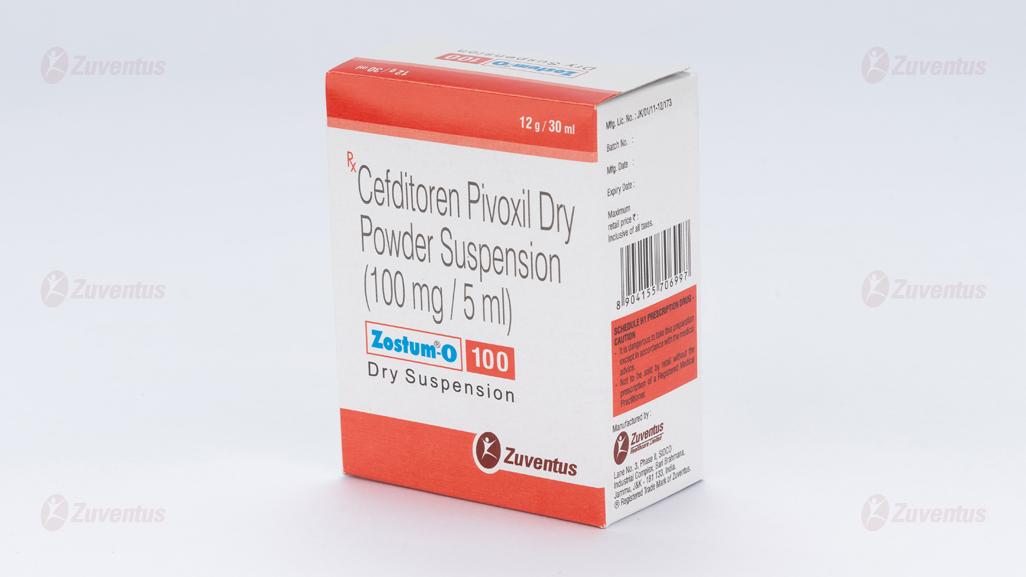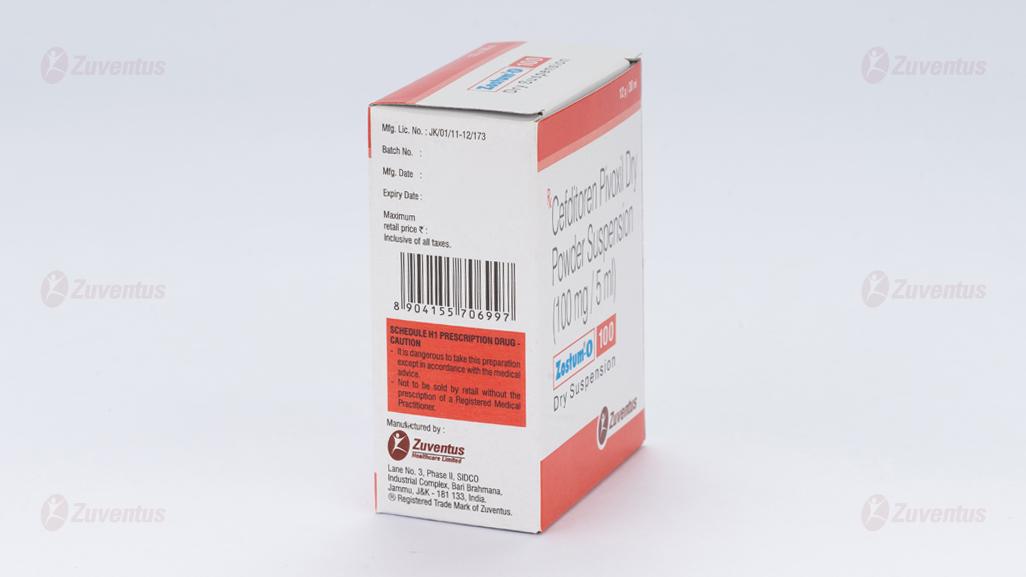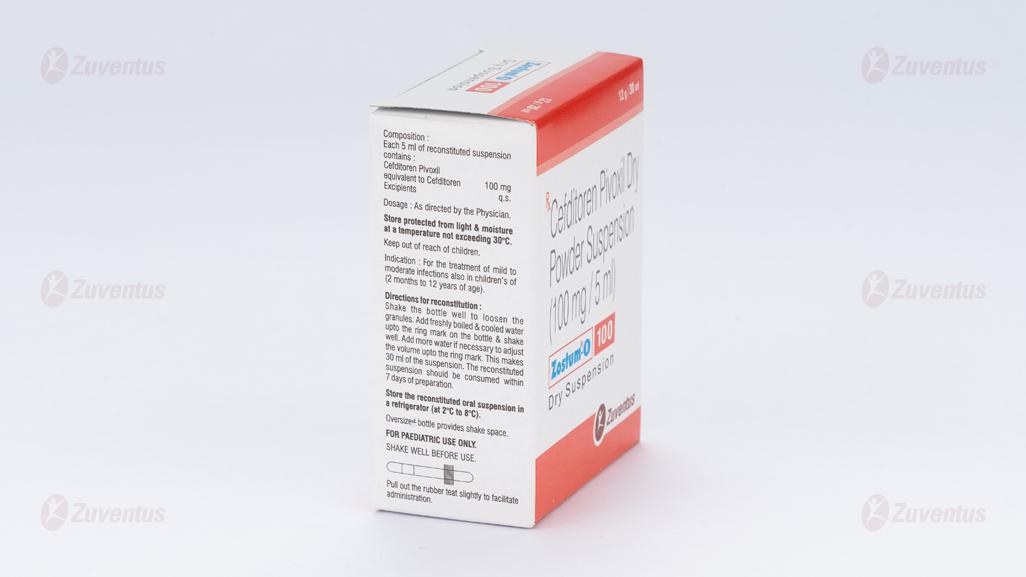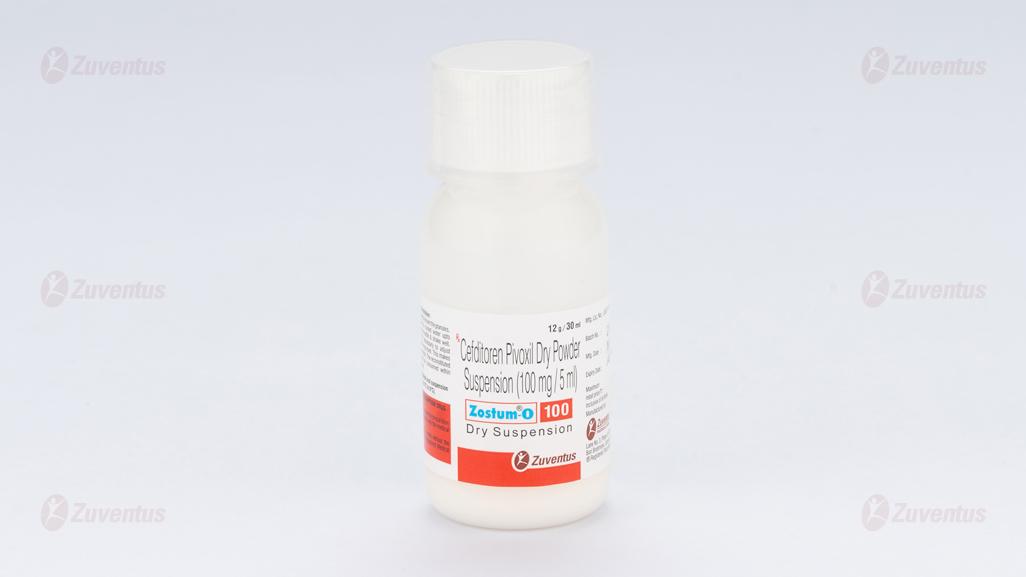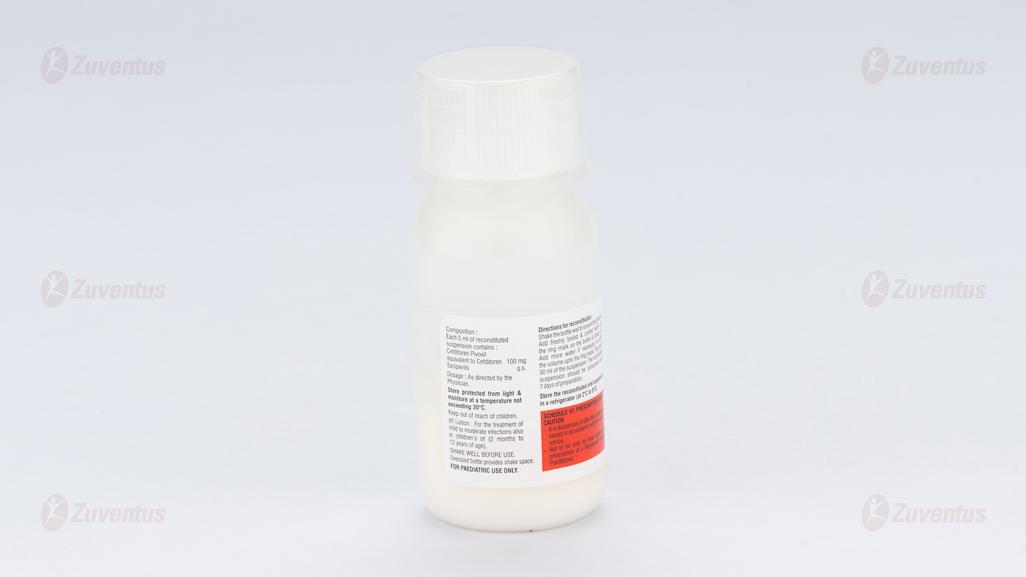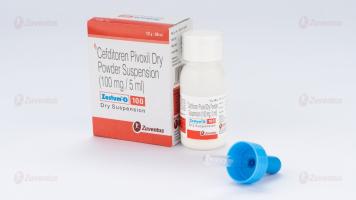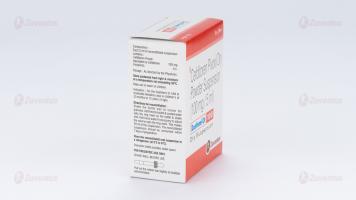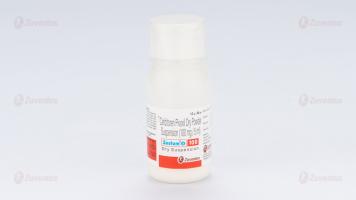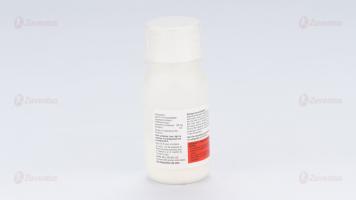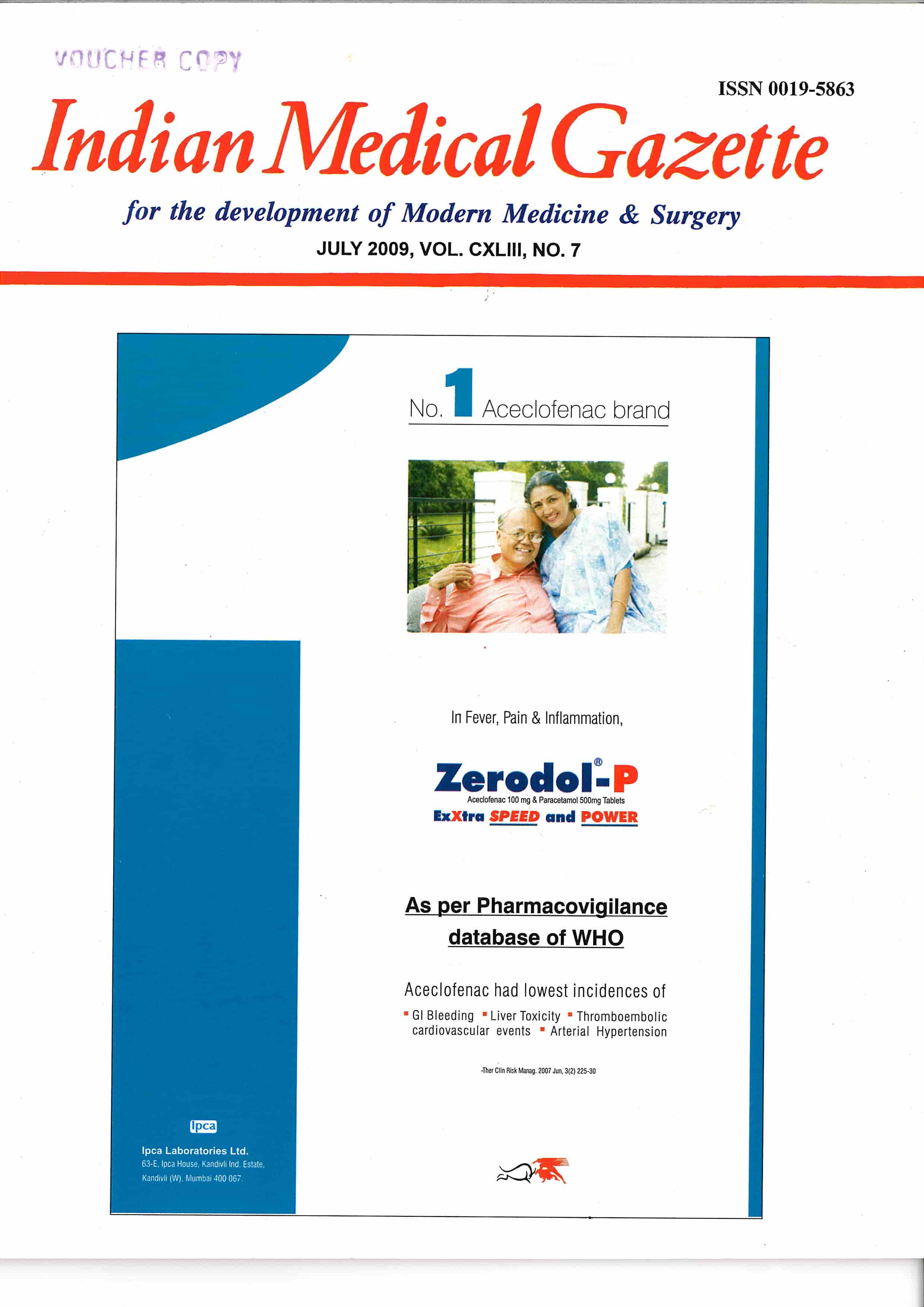Zostum O 100 Dry Suspension
Therapy Area
Anti Infective
1.0 Generic name
Cefditoren Pivoxil Dry Powder Suspension
2.0 Qualitative and quantitative composition
Each 5 ml of reconstituted suspension contains :
Cefditoren Pivoxil equivalent to Cefditoren 100 mg
Excipients q.s.
3.0 Dosage form and strength
Dry powder for Suspension
4.0 Clinical particulars
4.1 Therapeutic indication
Cefditoren pivoxil is indicated for the treatment of mild to moderate infections in children (2 months to 12 years of age) which are caused by susceptible strains of the designated microorganisms in the conditions listed below :
- Acute bacterial exacerbation of chronic bronchitis
- Community-acquired pneumonia
- Pharyngitis/tonsillitis
- Acute sinusitis
- Uncomplicated skin and skin-structure infections
4.2 Posology and method of administration
Recommended doses in children (2 months to 12 years of age)
For children with pneumonia, otitis media or sinusitis In general, 3 mg/kg/dose, 3 times a day, after meals. The dosage may be increased up to 6 mg/kg/dose as needed, but should not exceed 200 mg, 3 times a day (600 mg / day). For children with diseases other than above diseases In general, 3 mg/kg/dose, 3 times a day, after meals. The dosage may be adjusted according to the disease or the patient's age and symptoms, but should not exceed 200 mg, 3 times a day (600 mg /day).
Direction for reconstitution
Shake the bottle well to loosen the granules. Add freshly boiled and cooled water up to the ring mark on the bottle & shake well. Add more water if necessary to adjust the volume up to the ring mark. This makes 30 ml of suspension. The reconstituted suspension should be consumed within 7 days of preparation.
4.3 Contraindications
- Patients with known allergy to the cephalosporin class of antibiotics or any of its components
- Patients with carnitine deficiency or inborn errors of metabolism that may result in clinically significant carnitine deficiency, because use of Cefditoren causes renal excretion of carnitine.
4.4 Special warnings and precautions for use
- Before therapy with cefditoren pivoxil is instituted, careful inquiry should be made to determine whether the patient has had previous hypersensitivity reactions to cefditoren pivoxil, other cephalosporins, penicillins, or other drugs.
- If cefditoren pivoxil is to be given to penicillin-sensitive patients, caution should be exercised because cross-hypersensitivity among β-lactam antibiotics has been clearly documented and may occur in up to 10% of patients with a history of penicillin allergy.
- If an allergic reaction to cefditoren pivoxil occurs, the drug should be discontinued. Serious acute hypersensitivity reactions may require treatment with epinephrine and other emergency measures, including oxygen, intravenous fluids, intravenous antihistamines, corticosteroids, pressor amines, and airway management, as clinically indicated.
- Pseudomembranous colitis has been reported with nearly all antibacterial agents, including cefditoren pivoxil, and may range in severity from mild to life-threatening. Therefore, it is important to consider this diagnosis in patients who present with diarrhea subsequent to the administration of antibacterial agents.
- Treatment with antibacterial agents alters normal flora of the colon and may permit overgrowth of clostridia. Studies indicate that a toxin produced by Clostridium difficile is a primary cause of antibioticassociated colitis.
- After the diagnosis of pseudomembranous colitis has been established, appropriate therapeutic measures should be initiated. Mild cases of pseudomembranous colitis usually respond to drug discontinuation alone. In moderate to severe cases, consideration should be given to management with fluids and electrolytes, protein supplementation, and treatment with an antibacterial drug clinically effective against C. difficile colitis.
- Prescribing cefditoren pivoxil in the absence of a proven or strongly suspected bacterial infection or a prophylactic indication is unlikely to provide benefit to the patient and increases the risk of the development of drug-resistant bacteria
- Cefditoren pivoxil is not recommended when prolonged antibiotic treatment is necessary, since other pivalate-containing compounds have caused clinical manifestations of carnitine deficiency when used over a period of months. No clinical effects of carnitine decrease have been associated with short-term treatment.
- Community-acquired pneumonia clinical trials demonstrated no adverse events attributable to decrease in serum carnitine concentrations. However, some sub-populations (e.g., patients with renal impairment, patients with decreased muscle mass) may be at increased risk for reductions in serum carnitine concentrations during cefditoren pivoxil therapy.
- As with other antibiotics, prolonged treatment may result in the possible emergence and overgrowth of resistant organisms. Careful observation of the patient is essential. If superinfection occurs during therapy, appropriate alternative therapy should be administered.
- Prothrombin time should be monitored in patients at risk and exogenous vitamin K should be administered as indicated.
4.5 Drugs interactions
Oral Contraceptives
Multiple doses of cefditoren pivoxil had no effect on the pharmacokinetics of ethinyl estradiol, the estrogenic component in most oral contraceptives.
Antacids
Co-administration of a single dose of an antacid which contained both magnesium (800 mg) and aluminum (900 mg) hydroxides reduced the oral absorption of a single 400 mg dose of cefditoren pivoxil administered following a meal, as evidenced by a 14% decrease in mean Cmax and an 11% decrease in mean AUC. Although the clinical significance is not known, it is not recommended that cefditoren pivoxil be taken concomitantly with antacids.
H2-Receptor Antagonists
Co-administration of a single dose of intravenously administered famotidine (20 mg) reduced the oral absorption of a single 400 mg dose of cefditoren pivoxil administered following a meal, as evidenced by a 27% decrease in mean Cmax and a 22% decrease in mean AUC. Although the clinical significance is not known, it is not recommended that cefditoren pivoxil be taken concomitantly with H2 receptor antagonists.
Probenecid
As with other β-lactam antibiotics, co-administration of probenecid with cefditoren pivoxil resulted in an increase in the plasma exposure of cefditoren, with a 49% increase in mean Cmax, a 122% increase in mean AUC, and a 53% increase in t1/2.
4.6 Use in special populations
Pregnancy
Cefditoren pivoxil was not teratogenic up to the highest doses tested in rats and rabbits. There are no adequate and well-controlled studies in pregnant women. Because animal reproductive studies are not always predictive of human response, this drug should be used during pregnancy only if clearly needed.
Breast-feeding
Because many drugs are excreted in human breast milk, caution should be exercised when cefditoren pivoxil is administered to nursing women.
4.7 Effects on ability to drive and use machines
Cefditoren has no or negligible influence on the ability to drive or use machines. However, cefditoren may cause side effects influencing the capacity of reaction and the ability to drive and use machines.
4.8 Undesirable effects
As a result of post-marketing survey of cefditoren granules, total 5,821 clinical cases were reported from 875 facilities in Japan. The number of side effects was 136 cases (2.34%), and the number of adverse reactions occurred was 146 cases. The main adverse reactions were 121 cases (2.08%) of digestive tract disorders (diarrhea, loose stools, etc.), 10 cases (0.17%) of skin and skin structure disorders (rash, urticaria).
Serious side effects (<0.1%)
- Shock and anaphylaxis, severe colitis (as pseudomembranous colitis), toxic epidermal necrolysis (TEN), stevens-johnson syndrome, interstitial pneumonia, liver function disorder, severe kidney injury, agranulocytosis, hemolytic anemia if any of these disorders are recognized, stop administration immediately and take appropriate measures.
- Since hypoglycemia (frequency unknown) associated with hypocarnitinemia may be seen in cases in which antibiotics having pivoxil groups are administered to children (especially infants), hypoglycemic symptoms such as convulsions and disturbances of consciousness are observed. If so, discontinue administration and take appropriate measures
Other side effects
| Less than 0.1 to 5% | Less than 0.1% | |
| Hypersensitivity | Rash | Urticaria, erythema, itching, fever, lymphadenopathy, arthralgia |
| Blood | Eosinophilia | Granulocytopenia, thrombocytopenia |
| Liver | Rising AST (GOT), ALT (GPT) | Jaundice, elevation of Alkaline phosphatase |
| kidney | - | Increased BUN, elevated blood creatinine, proteinuria |
| G.I.T | Diarrhea, loose stools, nausea, stomach discomfort, abdominal pain |
Abdominal bloating, nausea, vomiting |
| Fungal infections | - | Stomatitis, candidiasis |
| Skin and subcutaneous tissue disorders | - | Fixed Drug Eruption (FDE) |
| Vitamin deficiency | - | Vitamin K deficiency symptoms (hypoprothrombinemia, bleeding tendency etc.), vitamin B deficiency symptoms (glossitis, mouth ulcer, anorexia, neuritis etc.) |
| Other | - | Headache, dizziness, edema, numbness |
Reporting of suspected adverse reactions
Reporting suspected adverse reactions after authorisation of the medicinal product is important. It allows continued monitoring of the benefit/risk balance of the medicinal product. Healthcare professionals are asked to report any suspected adverse reactions via email to : medico@zuventus.com
Website : https://www.zuventus.com/drug-safety-reporting
By reporting side effects, you can help provide more information on the safety of this medicine.
4.9 Overdose
Information on cefditoren pivoxil overdosage in humans is not available. However, with other β-lactam antibiotics, adverse effects following overdosage have included nausea, vomiting, epigastric distress, diarrhea, and convulsions. Hemodialysis may aid in the removal of cefditoren from the body, particularly if renal function is compromised (30% reduction of plasma concentrations following 4 hours of hemodialysis).
The stomach should be emptied by aspiration and gastric lavage. Vital parameters should be managed symptomatically and institute supportive measures as required.
5.0 Pharmacological properties
5.1 Mechanism of action
Cefditoren is bactericidal in nature and its activity results from the inhibition of cell wall synthesis via affinity for penicillin-binding proteins (PBPs). It has high affinity for penicillin binding protein (PBP) of various bacteria
5.2 Pharmacodynamic properties
Antibacterial activity Cefditoren pivoxil is metabolized into cefditoren on absorption in the intestinal wall and shows its antibacterial activity. Cefditoren exerts broad spectrum antibacterial activity in vitro against gram-positive and gram-negative bacteria. Especially it showed strong antibacterial activity against gram-positive bacteria such as Staphylococcus sp., Streptococcus sp. and Streptococcus pneumoniae, and gram-negative bacteria such as Escherichia coli, Moraxella (Branhamella) catarrhalis, Klebsiella sp., Proteus sp. and Haemophilus influenzae, and against anaerobic bacteria such as Peptostreptococcus sp., Propionibacterium acnes, Bacteroides sp. and Prevotella sp. Cefditoren also showed antibacterial activity against β-lactamase-non producing ampicillin resistant Haemophilus influenzae (BLNAR). In vitro, cefditoren was stable against β-lactamases produced by various bacteria, and showed strong antibacterial activity against β-lactamase-producing strains
5.3 Pharmacokinetic properties
Absorption and distribution
Following oral administration, cefditoren pivoxil is absorbed from the gastrointestinal tract and hydrolyzed to cefditoren by esterases.
Serum concentration and pharmacokinetic parameters of cefditoren were as shown in Table 1 when doses of 3 mg - 6 mg/kg were orally administered to pediatric patients with normal renal function. Table 1 : Pharmacokinetic parameters of normal pediatric patients with renal function.
| Dose | Cmax (μg / mL) | t½(hr) | AUC0"∞ (μg · hr / mL) |
| 3 mg / kg (n = 19) | 1.45 | 2.25 | 7.16 |
| 6 mg / kg (n = 18) | 2.85 | 1.68 | 11.90 |
After absorption cefditoren is distributed to different body fluids and tissues e.g. sputum, tonsil tissue, maxillary sinus mucosa, skin tissue, tooth extraction wound etc. Protein binding: The binding rate with human serum protein measured by ultrafiltration was 91.5% at a concentration of 25 μg / mL (in vitro).
Metabolism / Excretion
Cefditoren pivoxil undergoes metabolism upon absorption and becomes cefditoren and pivalic acid with antimicrobial activity. Pivalic acid undergoes carnitine conjugation and is excreted in the urine as pivaloylcarnitine. Cefditoren is excreted largely in urine and bile without much metabolism. Urinary excretion rate (0 to 8 hours) as cefditoren was about 20% and 17%, respectively, when orally administered 3 mg / kg, 6 mg / kg once or twice to pediatric patients with normal renal function. Urinary excretion rate decreased as the extent of impairment of renal function increased, and a delay of excretion was observed.
6.0 Non-clinical properties
6.1 Animal Toxicology or Pharmacology
No known animal toxicology data
7.0 Description
Zostum-O 100 Dry Suspension contains cefditoren pivoxil, a semi-synthetic cephalosporin antibiotic for oral administration. It is a prodrug which is hydrolyzed by esterases during absorption, and the drug is distributed in the circulating blood as active cefditoren
Chemical name : 2, 2-Dimethylpropanoyloxymethyl (6R, 7R)-7-[(Z)-2- (2-aminothiazol-4-yl)-2- (methoxyimino) acetylamino]-3-[(1Z)-2-(4-methylthiazol-5-yl) ethenyl]-8-oxo-5-thia-1-azabicyclo [4.2.0] oct-2-ene -2-carboxylate.

8.0 Pharmaceutical particulars
8.1 Incompatibilities
Not Applicable
8.2 Shelf Life
Refer on the pack.
8.3 Packaging Information
A bottle of 12 g / 30 ml
8.4 Storage and handing Instructions
Store protected from light & moisture at a temperature not exceeding 30°C.
Keep out of reach of children.
9.0 Patient counselling information
Parents or caregivers should be counselled that antibacterial drugs including Zostum-O 100 Suspension should only be used to treat bacterial infections. They do not treat viral infections (e.g., the common cold).
When Zostum-O 100 Suspension is prescribed to treat a bacterial infection, patients/ parents or caregivers should be told that although it is common to feel better early in the course of therapy, the medication should be taken exactly as directed. Skipping doses or not completing the full course of therapy may (1) decrease the effectiveness of the immediate treatment and (2) increase the likelihood that bacteria will develop resistance and will not be treatable by Zostum-O 100 Suspension or other antibacterial drugs in the future
Zostum-O 100 Suspension (cefditoren pivoxil) should be taken with meals to enhance absorption.
It is not recommended that Zostum-O 100 Suspension be taken concomitantly with antacids or other drugs taken to reduce stomach acids.
12.0 Date of revision
15 October 2022
About leaflet
The name of your medicine is Zostum-O 100 Dry Suspension (100 mg / 5 ml), which will be referred to as Zostum-O 100 Dry Suspension throughout this document.
Read all of this leaflet carefully before you start taking using this medicine because it contains important information for you.
- Keep this leaflet. You may need to read it again.
- If you have any further questions, ask your doctor or pharmacist.
- This medicine has been prescribed for you only. Do not pass it on to others. It may harm them, even if their signs of illness are the same as yours.
If you get any side effects, talk to your doctor or pharmacist. This includes any possible side effects not listed in this leaflet. See section 4.
What is in this leaflet
- What Zostum-O 100 Dry Suspension is and what it is used for
- What you need to know before you take Zostum-O 100 Dry Suspension
- How to take Zostum-O 100 Dry Suspension
- Possible side effects
- How to store Zostum-O 100 Dry Suspension
- Contents of the pack and other information
1. What Zostum-O 100 Dry Suspension is and what it is used for
Zostum-O 100 Dry Suspension made from granules of the active ingredient cefditoren pivoxil, which is an antibiotic. Zostum-O 100 Dry Suspension is used to treat the following infections caused by bacteria that can be killed by cefditoren pivoxil:
Cefditoren pivoxil is used for the treatment of mild to moderate infections in children of 2 months to 12 years of age which are caused by susceptible strains of the designated microorganisms in following infections:
- Exacerbation of chronic bronchitis
- Infection of lung tissue (pneumonia)
- Throat infections including tonsillitis and pharyngitis
- Infection of the sinuses (acute sinusitis)
- Skin and soft tissue (e.g. muscle) infections
2. What you need to know before you take Zostum-O 100 Dry Suspension
Do not take Zostum-O 100 Dry Suspension:
- if you are allergic (hypersensitive) to cefditoren pivoxil, any cephalosporin (other similar antibiotics) or any of the other ingredients of this medicine (listed in Section 6). An allergic reaction may include rash, itching, difficulty breathing or swelling of the face, lips, throat or tongue.
- Patients with carnitine deficiency or inborn errors of metabolism that may cause carnitine deficiency, because use of cefditoren causes renal excretion of carnitine
Warnings and precautions
Talk to your doctor or pharmacist before taking Zostum-O 100 Dry Suspension if you
- have had an allergic reaction to penicillins or other drugs in the past
- have a history of gastrointestinal disease, especially inflammation of the colon (colitis)
- have severe kidney problems
Tell your doctor if you are having blood or urine tests. Zostum-O 100 Dry Suspension may interfere with these tests.
Other medicines and Zostum-O 100 Dry Suspension
Tell your doctor or pharmacist if you are taking, have recently taken or might take any other medicines, including medicines obtained without a prescription. This is especially important of the following, as they may interact with your Zostum-O 100 Dry Suspension:
- Antacids (reduces stomach acidity)
- H2-Receptor antagonists (reduces stomach acidity)
- Probenecid (a treatment for gout)
It may still be all right for you to be given Zostum-O 100 Dry Suspension and your doctor will be able to decide what is suitable for you.
Pregnancy and breast-feeding
If you are pregnant or breast-feeding, think you may be pregnant or are planning to have a baby, ask your doctor or pharmacist before taking this medicine.
Driving and using machines
Zostum-O 100 Dry Suspension should not affect your ability to drive or use machines.
3. How to take Zostum-O 100 Dry Suspension
Always take this medicine exactly as your doctor has told you. Check with your doctor or pharmacist if you are not sure. Shake well before use.
Direction for reconstitution
Shake the bottle well to loosen the granules. Add freshly boiled and cooled water upto the ring mark on the bottle & shake well. Add more water if necessary to adjust the volume upto the ring mark. This makes 30 ml of suspension. The reconstituted suspension should be consumed within 7 days of preparation.
Dosage
Recommended doses in children (2 months to 12 years of age)
- For children with pneumonia (lung infection), otitis media (ear infection) or sinusitis (paranasal sinus infection):
In general, 3 mg/kg/dose, 3 times a day, after meals. The dosage may be increased up to 6 mg/kg/dose as needed, but should not exceed 200 mg, 3 times a day (600 mg / day).
- For children with diseases other than above diseases:
In general, 3 mg/kg/dose, 3 times a day, after meals. The dosage may be adjusted according to the disease or the patient's age and symptoms, but should not exceed 200 mg, 3 times a day (600 mg /day).
If you take more Zostum-O 100 Dry Suspension than you should
Go to the nearest accident and emergency (casualty) department or tell your doctor straight away
If you forget to take Zostum-O 100 Dry Suspension
If you miss a dose, take one as soon as you can. If you have missed several doses, tell your doctor. If you have any further questions on the use of this medicine, ask your doctor or pharmacist.
4. Possible side effects
Like all medicines, this medicine can cause side effects, although not everybody gets them. All medicines can cause allergic reactions, although serious allergic reactions are very rare. Tell your doctor immediately if you get any sudden wheeziness, difficulty in breathing, swelling of the eyelids, face, lips or limbs, rash or itching (especially affecting your whole body).
Serious side effects
The following side effects are serious. You should stop taking this medicine and contact your doctor immediately if you experience them:
- Serious peeling or blistering of the skin
- Severe diarrhoea, possibly with blood or mucus
- Low blood sugar (glucose) level symptoms such as sweating, fast heartbeat, seizures and disturbances of consciousness are observed. If so, discontinue administration and take appropriate measures
The following side effects have been reported
Commonly seen side effects of digestive tract disorders (diarrhea, loose stools, etc.), skin and skin structure disorders (rash, urticaria)
Other side effects have been reported
- Headache, dizziness, edema, numbness
- Rash, urticaria, erythema, itching, fever, lymphadenopathy, arthralgia
- Changes in blood counts
- Jaundice (yellow skin and eyes)
- Damage to your liver or kidneys which can only be detected by a blood and / or urine test
- Abdominal bloating, nausea, vomiting, nausea, stomach discomfort, abdominal pain
- Fungal infections- Stomatitis, itching of the vagina caused by thrush (candidiasis)
- Vitamin K deficiency symptoms (hypoprothrombinaemia, bleeding tendency etc.), vitamin B deficiency symptoms (glossitis, mouth ulcer, anorexia, neuritis etc.)
Reporting of side effects
If you get any side effects, talk to your doctor or pharmacist. This includes any possible side effects not listed in this leaflet.
You can also report side effects to medico@zuventus.com and you can report directly via the national pharmacovigilance program of India by calling on 1800 180 3024. By reporting side affects you can help provide more information on the safety of this medicine.
5. How to store Zostum-O 100 Dry Suspension
Keep this medicine out of the sight and reach of children. Store in cool place. Protect from moisture Keep containers tightly closed and protect from light. Do not use this medicine after the expiry date which is stated on the bottle. The expiry date refers to the last day of that month. After it is made up, the suspension should be stored in a refrigerator (2-8°C) and should be consumed within 7 days of preparation. Do not throw away any medicines via wastewater or household waste. Ask your pharmacist how to throw away medicines you no longer use. These measures will help protect the environment.
6. Contents of the pack and other information
What Zostum-O 100 Dry Suspension contains
- Each 5 ml of reconstituted suspension contains: Cefditoren Pivoxil equivalent to Cefditoren 100 mg
- Excipients (q.s.)
Manufacturer
Zuventus Healthcare Ltd
Lane No. 3, Phase-II, SIDCO,
Bari-Brahmana, Jammu - 181 133, India.
® Registered Trade Mark of Zuventus.
Marketing Authorisation Holder
Zuventus Healthcare Ltd
® Registered Trade Mark of Zuventus.


